History of Strensham services
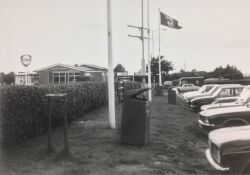
The original building, in the 1970s.

As Britain was preparing to embrace the motorway era, one of the highest priorities was providing a new route between the West Midlands and South Wales. Long before Watford Gap was finished, plans were being drawn up for Strensham services.
The M5 in fact allowed for two service areas: Strensham and Newland Common were confirmed in February 1960. Strensham would be built first because it was close to the M50, though it would soon turn out that it was built too close to the M50; it was less than half a mile between the two exits. Mistakes were made with the M5 itself too: two lanes would soon prove to be far too narrow.
£160,000 was spent on preparing the two service areas (around £3million in 2025).
Tendering
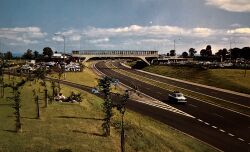
See also: M5 Service Area Planning
The tendering for Strensham was held back to allow everybody to learn lessons from the first two services, but by June 1960 it was decided that it couldn't wait any longer. The M1's service areas still weren't fully open and no feedback was available. The only lesson learned was that the Ministry shouldn't offer to pay for a roof on the footbridge, because the developer would want walls to be fitted too.
Kenning Motor Group used London-based architects Sir Thomas Bennett & Sons to produce a successful bid similar in style and finance to what Blue Boar had used at Watford Gap. Blue Boar did in fact bid for Strensham themselves, but the strain of running Watford Gap had caused them to restrict their design and financial offer.
Like Blue Boar, Kenning were from a motoring background so they leased their catering to Northern Caterers Ltd. The partnership caused delays as Northern Caterers demanded the best possible facilities, while Kenning were trying to reduce construction costs.
The site was 11 acres in size. The contract required that at least 12 toilets would be provided; a figure which was later described as "hopelessly inadequate". The forecourt needed a minimum of 12 pumps across two brands, but Kenning went for 21 pumps and five brands: these were Shell, National Benzole, Fina, BP and Power.
The tiny amount of land available was reduced further by a maintenance compound and a police post being added to the northbound side.
Design
Ministry of Transport, 1963.
The design consisted of a small café on each side of a covered footbridge, with a larger restaurant on the northbound side. The two buildings were built close to the motorway. They then applied pleasant landscaping to the design, and mirrored this layout in number of applications across the country, such as when Kenning applied for Keele. The emphasis on greenery and landscaping really sticks out compared with the service areas built in the following years.
The footbridge between the two sides was designed to stand out, creating a distinctive landmark to identify the service area by. The Royal Fine Art Commission objected to such a design. A debate over the layout of the maintenance compound caused further delays.
The building's walls were brick with straw thatching. Both restaurant options were simply furnished, the main one being advertised as open the very precise hours of 09:15 to 20:55. It had blue plastic seats, a carpet and curtains.
The café had a tiled floor with red and blue tables and high-backed settees. Kenning used the name Signpost Coffee House & Grill. The restaurant, seating 100, was built on a terrace so advantage could be taken of the "attractive scenery" surrounding the area. It had a small entrance hall where the toilets were.
Work was accelerated and the transport café and forecourt were able to open on 20 July 1962, with the restaurant opening on 16 August 1962, with a ceremony attended by Lord Chesham. Pictures of the building were used on postcards and adverts. Kennings spent a total of £217,000 on the project (around £4million in 2025).
Early Failings
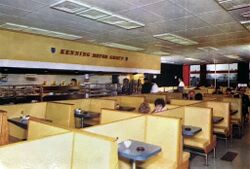
Upon opening, the building was criticised for being "driven by economy", with most of its budget spent on the bridge. The buildings appeared "poor" and did not tie together; the architects were also criticised.
Kenning seemed to already be getting nervous, suggesting they weren't sure if their investment was going to pay off. They had to be encouraged to keep Strensham going, and continued to invest heavily in it.
The big problem that had been caused at Strensham was that the restaurants couldn't adapt to the variable traffic levels. It was reaching full capacity by 1963, but the restaurant was losing money and the café was having its opening hours reduced. An inspector notes that the café, which was also due to be extended, was usually empty.
A more frank 1975 review described the layout of the service areas as "disastrous", with "low quality" buildings, a confusing car park and a footpath which sent pedestrians through the forecourt. The whole complex was being squeezed into too small a space and this made it difficult to route traffic and pedestrians while still providing greenery and enough parking. The review pushed for the whole complex to be redesigned from scratch, which would eventually happen. Overcrowding hit a particular peak in July 1976, when the media reported people were parking on the hard shoulder.
Egon Ronay rated the restaurant as "acceptable" and the café as "poor" in his 1977 visit. One meal he highlighted was a soup which came "straight from the packet" and was still "carelessly cooked". When The Mirror visited in August 1980, they said it was "very scruffy", with "typical motorway standard" food. The Coffee House and Grill sold plaice and fries for £2.15 (about £9 in 2025).
The service area was slow to adapt to changing customer expectations, sticking with its grill-restaurant, because everything had been planned on the assumption that this would be a popular option. Even if not many people were eating, the buildings were getting very cramped, and by the 1980s a second storey had been added to the amenity buildings. The main restaurant was now called 'Hill View'.
A new southbound café was opened in 1989, called Milestone, while a take-away called Jetburger opened on the northbound side. Egon Ronay graded the service area as "poor" when he visited again, calling it "noisy and unpleasant", adding that "eating our shoes [would be] a preferable option".
A Which? survey dated 1991 told motorists to avoid the service area because of its drab restaurant, small car parks and poor toilets. It was widely reported to be the worst service area in Britain, and staff morale was thought to be low. Changes were needed.
Changes
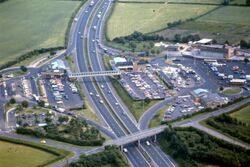

Kenning fell under new management in 1992, who felt that their one motorway service area didn't fit the rest of the business, so Strensham was put up for sale in April 1994. Pavilion were interested, but a management buyout saw Take A Break take over in July.
Family-run Take A Break had a favourable reputation. They had a red-and-yellow colour scheme with sections of the service area marked 'Take A Bite', 'Take A Burger', 'Take A Pick', 'Take A Rest' and 'Take A Chance'. The breakdown service was sold to Eriksons.
An independent operation like Take A Break were vulnerable to a take over, and fell to Roadchef on 30 July 1998. It went on to become Roadchef's busiest and most profitable site.
Northbound Relocation
The two-lane M5 became one of the first motorways in the UK to be famous for its severe congestion. A thorough improvement scheme took place in 1991 which involved building a whole new motorway with a better alignment and an extra lane.
To allow this to happen, the northbound service area and the connecting bridge were both demolished. A replacement northbound service area was built one mile to the north, to allow much more space between this and the junction to the south, which had also shifted north slightly. Temporary buildings were used at the old site until the new northbound building was ready.
The new £10million northbound service area (£22million in 2025) opened on 17 November 1992 and included the largest forecourt in Europe at the time with 32 pumps, and parking available for 360 cars, 130 HGVs and 15 coaches. The new site also included a 450-seater restaurant, burger bar, shop, picnic area and amusement arcade. A hotel was added in 1995.
The air ambulance base was unveiled by Take A Break in 1998. It switched to 24 hour opening in 2024.
The old northbound service area then became a works depot, with direct access from the new roundabout only. An auxiliary lane was built between the improved junction and the new service area, and Strensham became the only service area in the country with its own dedicated lane from the motorway, a claim to fame that was unique until 2017.
The new northbound service area was designed to cater for typical traffic levels until 2015, which it did, with the first significant extension opening in June 2015.
Southbound Reconstruction
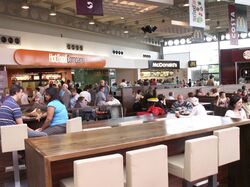
The southbound service area had survived the roadworks, but received a realigned entry slip road and a new exit that fed straight into the next junction. The site was still crowded and the building old-fashioned, so further changes were inevitable.
The southbound petrol station was moved to a larger site closer to the exit. The old petrol station, and the transport café positioned next to it, were demolished to create coach parking.
In 1999, the southbound amenity building had a small set of steps covered by a glass roof, with three new retail units (an old game arcade) on the right in a foyer. Through the doors into the main building, there were toilets on the immediate left and larger, older shop was then in the right-back corner, with amusement arcades straight ahead. Turning left was the servery, up the steps, with the kitchen on the left and seating all around it.
Roadchef had added a Cafe Continental to the foyer, and a Wimpy to the restaurant. They were looking at introducing a Costa and Wimpy Chicken, but they reported that Strensham southbound "under-performs significantly" and came up with a bigger plan instead.
Roadchef demolished this building in 2002, replacing it with a new, airy, glass, cuboid building, a common design from them at the time. The new building was in the site of the old car park and vice-versa.
The original plan for the new southbound service area included a mini-roundabout at the entrance to the car park, but this was changed in case it caused queues. Managing the high volumes of traffic that enter Strensham has proven to be a challenge, and in 2015 an unusual road layout was created where two parallel lanes flow into the car park together. By this stage, the southbound forecourt on its own was BP's most valuable, selling 23 million litres of fuel per year.
There was a plan to build a hotel at the northern edge of the southbound service area in 2005, but this was rejected, partially because the service area was already struggling to keep up with demand. Instead, that area was used as an overflow car park, trying to squeeze as much capacity out of what's available as possible.
In 2010, a traffic count revealed the southbound service area was significantly busier than the northbound one, attracting approximately 3% more traffic. This probably followed the 2008 refurbishment.
Despite the reconstruction of the service station, several reconfigurations of the car park and the reconstruction of the M5 itself, there is one single street light, positioned at the slip road leaving the M5 southbound, which dates back to 1962. It is on Roadchef's land but positioned far enough away to be forgotten about (and would probably require a road closure to maintain it). This makes it a good contender for the longest-surviving, unchanged, feature on Britain's motorway network.
Recent Rearrangements
Given its high trade, Strensham has been a popular site for Roadchef to experiment with new layouts.
A Costa Drive Thru was trialled on the northbound side in 2003, which claimed to be the 'first drive thru providing just coffee'.
A £1.6million investment (around £3million in 2025) in the southbound service area saw McDonald's, WHSmith, Hot Food Co and the locally-based Soho Coffee Co trialled here in 2008, the first two of which were rolled out nationwide. As well as snacks, Soho Coffee had a salad bar and a grill, and in July 2012 it opened on the northbound side too.
This trial brand arrangement was moved around for the first time in 2016. Hot Food Company became a large Fresh Food Café, and Soho Coffee was removed from both sides.
On the northbound side, an extension allowed for a trial of SPAR in 2015. It also held on to a Pizza Hut Express long after the others had been removed from the motorway network, lasting until 2014.
Another large refurbishment took place in the southbound side in 2017. Valued at £5million (around £7million in 2025), this included the opening of a Leon restaurant in August, and then in March 2018 a new SPAR shop with a Dolcetti Ice Cream counter opened. Shortly afterwards a flagship Boots store opened, while McDonald's and Costa were refurbished.
The northbound petrol station was operated directly by Roadchef, but it was sold to Euro Garages in early 2018. Even under Roadchef ownership, it was unusual in that it advertised a Roadchef-operated Subway and JJ Beano's, with fuel provided under the Texaco and Star Market names. With Euro Garages it is now branded BP, with the Subway and a SPAR that competes with the one in the main shop. Following the coronavirus lockdown in 2020, the Subway store permanently closed. It was later replaced with a large Rollover counter.
The Boots store closed in January 2020 following an unsuccessful return to the motorway network. This was later replaced with some contactless Costa Express machines.
Prezzybox opened a store on the southbound side around a similar time, with what was their only physical store. This closed in summer 2022 owing to rising product costs and low trade.
The southbound Phone Tech store was relocated from next to the toilets to the former Boots unit in August 2022, to make way for a new Changing Places toilet. The contactless Costa Express machines were also relocated around the corner next to the Costa kiosk.
The motorway network's first dedicated sensory room opened at Strensham in October 2022.
The northbound side received several refurbishments in Winter 2022, with a new LEON restaurant the first to open on 22 November 2022 and a refurbished Costa Coffee store following on 16 December 2022. Minor adjustments were also made to the SPAR and WHSmith stores. The Cornish Bakery unit also later received new brand signage along with each catering unit receiving their own individual seating areas, as opposed to one shared seating area previously.
In Popular Culture

The M5 past Strensham services was severely affected by the floods of July 2007. The service area, which wasn't itself affected, was used by stranded motorists. The site manager, Quintin Speers, was praised for his work over several days, to help those stuck in the floods and in the queues.
Strensham was the subject of a fly-on-the-wall documentary called 'Motorway Madness', which aired in October 2010 on Five.